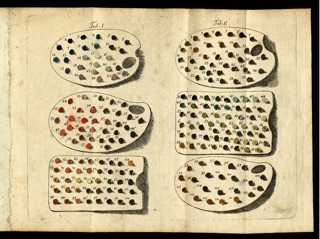Giulia Simonini
Eighteenth-century european Color Charts. History of Their Development and Application

In eighteenth-century Europe, the production of painted color charts increased enormously, whereas colored examples prior to this period are extremely rare. This production bridged the theoretical color investigation of natural philosophers and natural historians and the practical knowledge of artists, dyers, traders, craftsmen, and chemists. Thus, during the long eighteenth century, color charts became the intersection between theoretical and practical approaches, a place of interdisciplinarity and the link between academic knowledge and the science of practitioners. Hence, colored color charts originated in the context of a trading zone, as defined by Pamela O. Long. From a purely historical point of view and given their interdisciplinary nature, color charts do not fit well in this or that field of color research or color knowledge and their understanding has always been limited to one single branch of investigation. In the literature on color research or color knowledge, historians of science and art have always talked about color systems and more recently of color reference systems, whereas conservators and restorers about color model books. However, according to the first results of this research, all categories have distinguished themselves as two aspects of the way the broader phenomenon of color charts.
What colored color charts are exactly, what they were used for, and why their production increased enormously in the eighteenth century are therefore the starting questions of this dissertation project. To this end, a large number of handwritten and printed sources from various disciplines, such as art technology, natural sciences, dyeing, and chemistry, will be considered, researched and combined across the European panorama. Tradition strands of color charts will be highlighted, the principles of their creation will be determined, and the question of whether they have ever really found a practical application or not will be posed.
Personal Data
Giulia Simonini is a graduate conservator (B.A. Accademia di Belle Arti di Bologna), art historian (M.A. Technische Universität Berlin), and current Ph.D. candidate and research assistant to Prof. Dr Friedrich Steinle (Institute for the History of Science, Technische Universität Berlin) in the research project “The Order of Colours. Colour Systems and Colour Reference Systems in Eighteenth-Century Europe”. She is freelance palaeographer, and worked previously as assistant to Prof. Dr Rafał Makała (History of Eastern European Art, Technische Universität Berlin), as a research assistant to Prof. Dr Aleksandra Lipińska in the pilot project “Loitz Network” (History of Eastern European Art, Technische Universität Berlin), and as a student assistant to Prof. Dr Sven Dupré in the research group “Art and Knowledge in Pre-Modern Europe” (Max-Planck-Institute for the History of Science, Berlin).
She is the author of “Daniel Weiman & Libri picturati A 16–31” published in Archives of Natural history 45.1 (2018), and of “Organising Colours: Patrick Syme’s Colour Chart and Nomenclature for Scientific Purposes”, XVII-XVIII [En ligne], 75 | 2018, mis en ligne le 31 décembre 2018. URL: journals.openedition.org/1718/1327 ; DOI: 10.4000/1718.1327 Email: giulia.simonini@tu-berlin.de or giulia.posta17@gmail.com
| Supervisory Team | |
|---|---|
| Primary Supervisor | Prof. Dr. Friedrich Steinle TU Berlin |
| Secondary Supervisor | Prof. Dr. Karin Leonhard, Universität Konstanz |
